Volkswagen Company: Management Accounting and Business Strategies
VerifiedAdded on 2023/06/07
|14
|3160
|194
Report
AI Summary
This report provides a comprehensive analysis of the Volkswagen company, examining its establishment, vision, mission, managerial highlights, and product focus. It delves into the value chain of Volkswagen, outlining primary and supporting activities. The report further explores Volkswagen's business planning strategies, controlling mechanisms, and decision-making processes. A key focus is on the management accounting tools currently employed by the company, such as budgeting and total quality management. The report concludes by recommending additional management accounting tools, including standard costing and the balanced scorecard, to enhance the company's efficiency and competitiveness in the automotive industry. The analysis highlights key performance indicators and strategic initiatives, offering insights into Volkswagen's operations and future prospects.
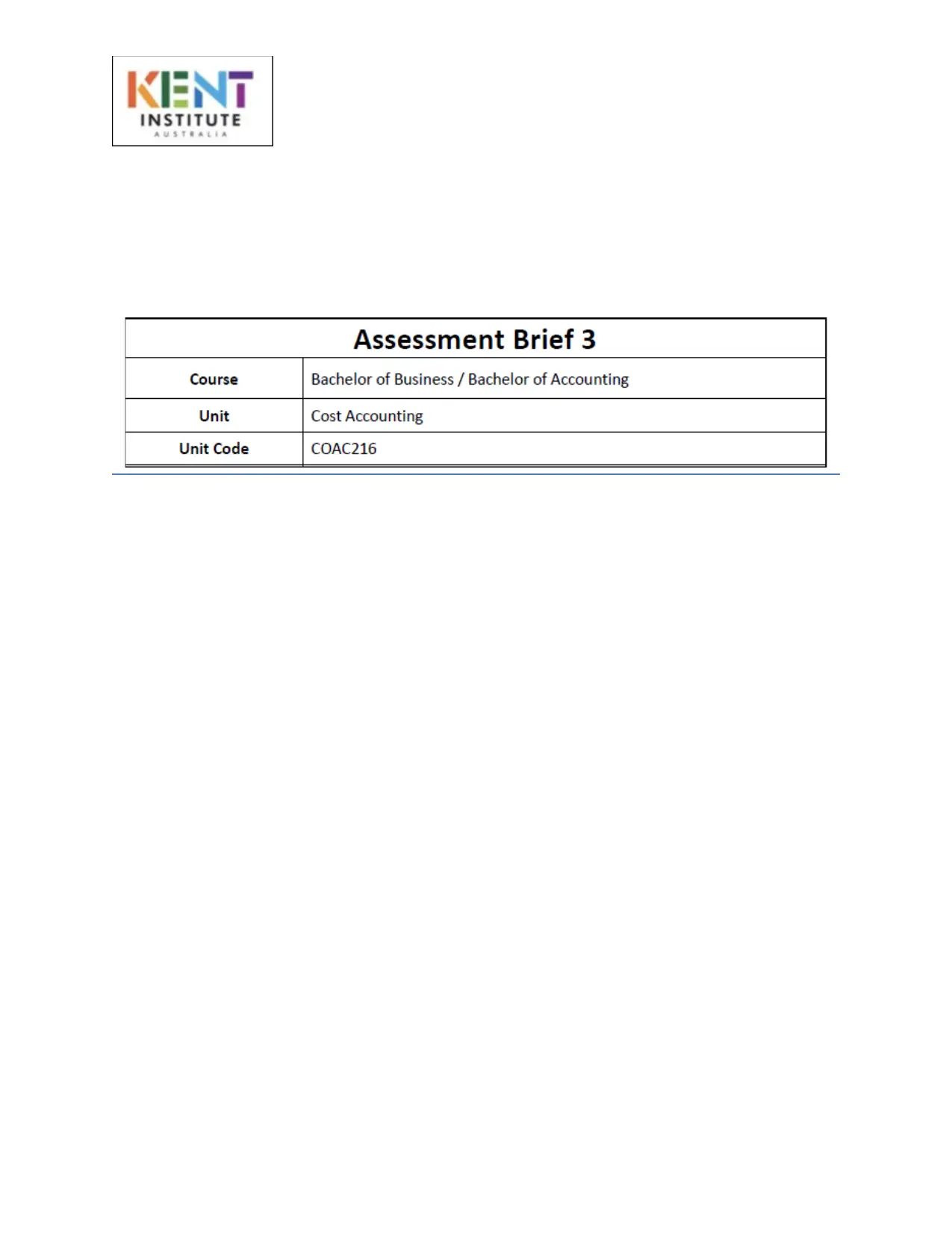
Paraphrase This Document
Need a fresh take? Get an instant paraphrase of this document with our AI Paraphraser
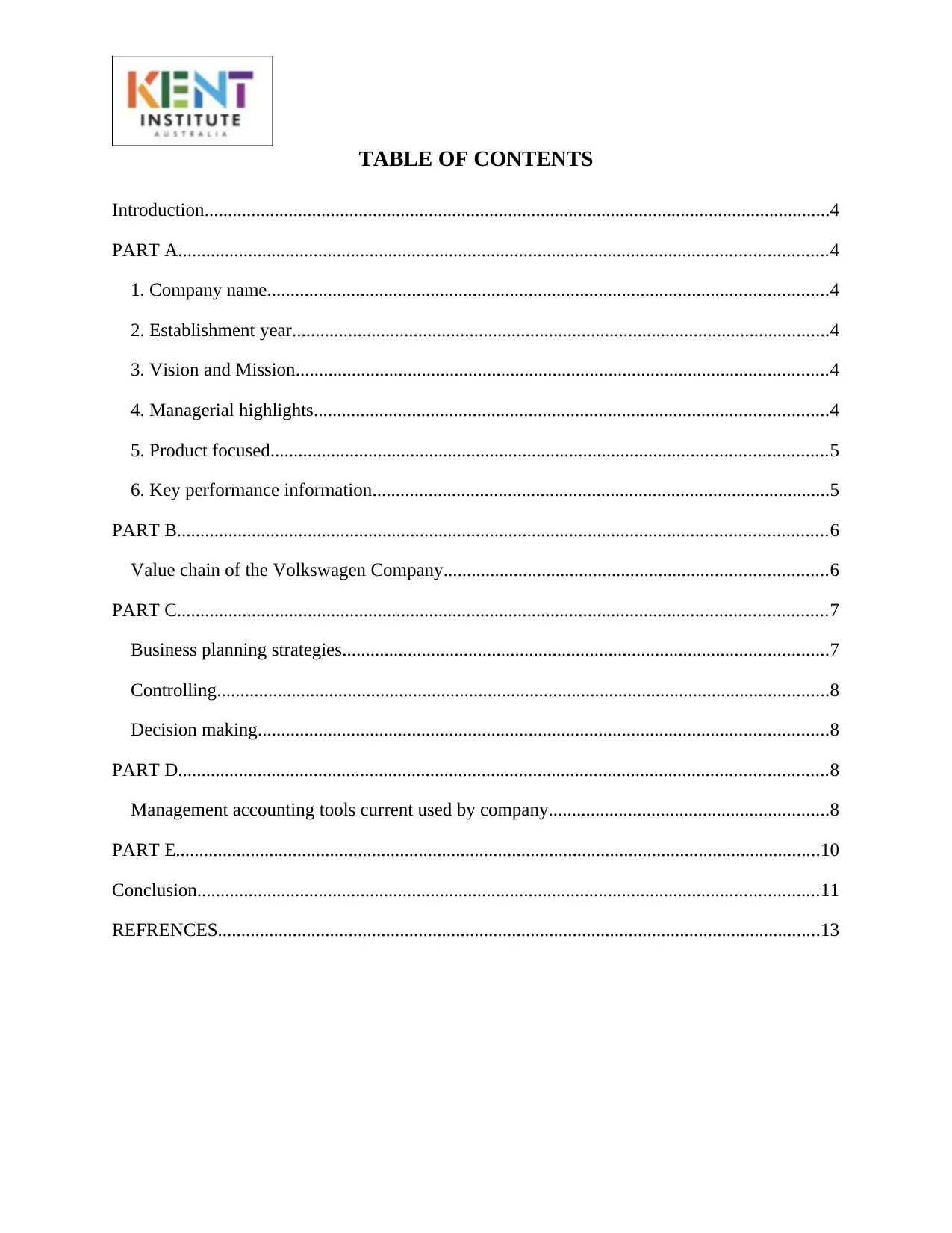
TABLE OF CONTENTS
Introduction......................................................................................................................................4
PART A...........................................................................................................................................4
1. Company name........................................................................................................................4
2. Establishment year...................................................................................................................4
3. Vision and Mission..................................................................................................................4
4. Managerial highlights..............................................................................................................4
5. Product focused.......................................................................................................................5
6. Key performance information..................................................................................................5
PART B...........................................................................................................................................6
Value chain of the Volkswagen Company..................................................................................6
PART C...........................................................................................................................................7
Business planning strategies........................................................................................................7
Controlling...................................................................................................................................8
Decision making..........................................................................................................................8
PART D...........................................................................................................................................8
Management accounting tools current used by company............................................................8
PART E..........................................................................................................................................10
Conclusion.....................................................................................................................................11
REFRENCES.................................................................................................................................13
Introduction......................................................................................................................................4
PART A...........................................................................................................................................4
1. Company name........................................................................................................................4
2. Establishment year...................................................................................................................4
3. Vision and Mission..................................................................................................................4
4. Managerial highlights..............................................................................................................4
5. Product focused.......................................................................................................................5
6. Key performance information..................................................................................................5
PART B...........................................................................................................................................6
Value chain of the Volkswagen Company..................................................................................6
PART C...........................................................................................................................................7
Business planning strategies........................................................................................................7
Controlling...................................................................................................................................8
Decision making..........................................................................................................................8
PART D...........................................................................................................................................8
Management accounting tools current used by company............................................................8
PART E..........................................................................................................................................10
Conclusion.....................................................................................................................................11
REFRENCES.................................................................................................................................13
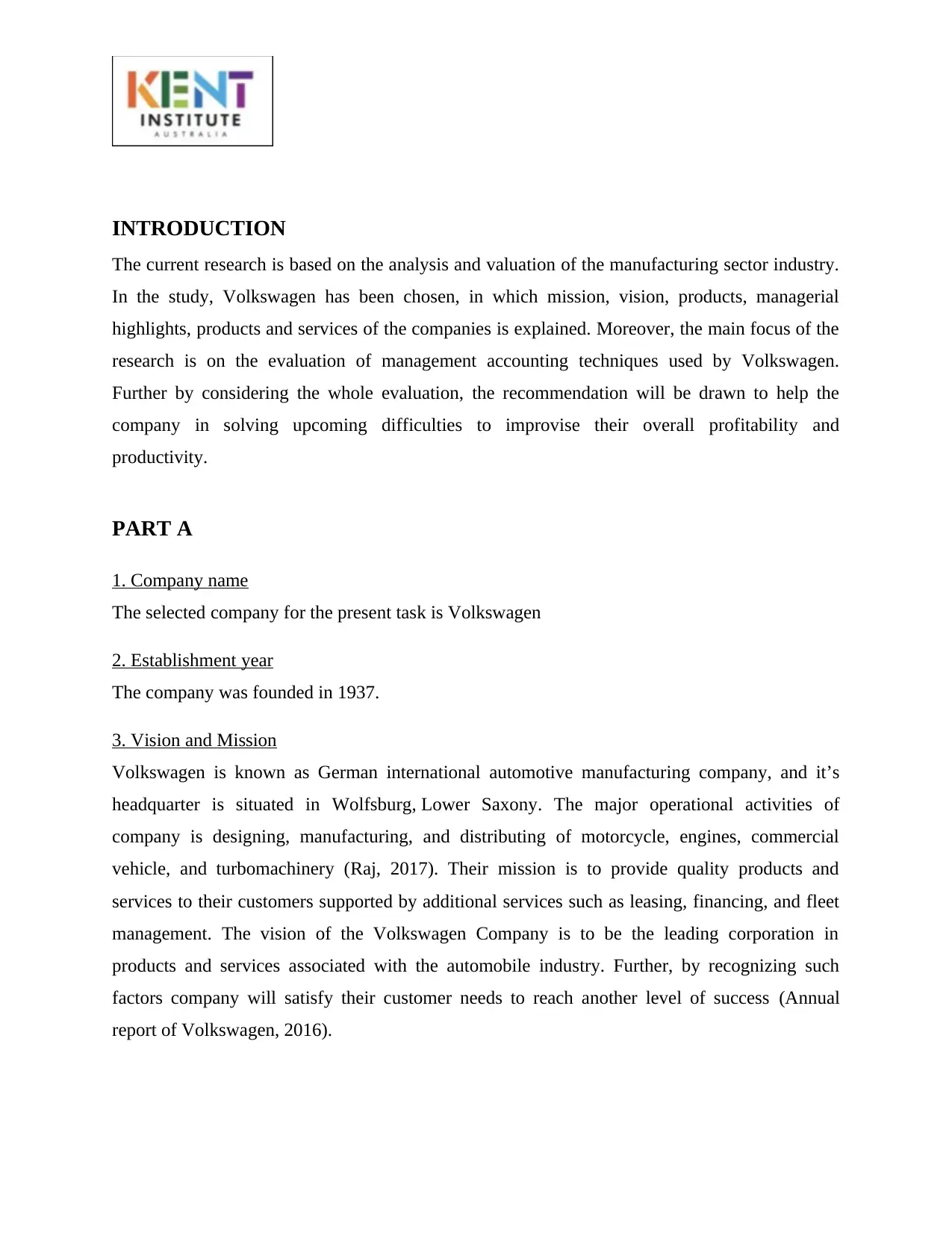
INTRODUCTION
The current research is based on the analysis and valuation of the manufacturing sector industry.
In the study, Volkswagen has been chosen, in which mission, vision, products, managerial
highlights, products and services of the companies is explained. Moreover, the main focus of the
research is on the evaluation of management accounting techniques used by Volkswagen.
Further by considering the whole evaluation, the recommendation will be drawn to help the
company in solving upcoming difficulties to improvise their overall profitability and
productivity.
PART A
1. Company name
The selected company for the present task is Volkswagen
2. Establishment year
The company was founded in 1937.
3. Vision and Mission
Volkswagen is known as German international automotive manufacturing company, and it’s
headquarter is situated in Wolfsburg, Lower Saxony. The major operational activities of
company is designing, manufacturing, and distributing of motorcycle, engines, commercial
vehicle, and turbomachinery (Raj, 2017). Their mission is to provide quality products and
services to their customers supported by additional services such as leasing, financing, and fleet
management. The vision of the Volkswagen Company is to be the leading corporation in
products and services associated with the automobile industry. Further, by recognizing such
factors company will satisfy their customer needs to reach another level of success (Annual
report of Volkswagen, 2016).
The current research is based on the analysis and valuation of the manufacturing sector industry.
In the study, Volkswagen has been chosen, in which mission, vision, products, managerial
highlights, products and services of the companies is explained. Moreover, the main focus of the
research is on the evaluation of management accounting techniques used by Volkswagen.
Further by considering the whole evaluation, the recommendation will be drawn to help the
company in solving upcoming difficulties to improvise their overall profitability and
productivity.
PART A
1. Company name
The selected company for the present task is Volkswagen
2. Establishment year
The company was founded in 1937.
3. Vision and Mission
Volkswagen is known as German international automotive manufacturing company, and it’s
headquarter is situated in Wolfsburg, Lower Saxony. The major operational activities of
company is designing, manufacturing, and distributing of motorcycle, engines, commercial
vehicle, and turbomachinery (Raj, 2017). Their mission is to provide quality products and
services to their customers supported by additional services such as leasing, financing, and fleet
management. The vision of the Volkswagen Company is to be the leading corporation in
products and services associated with the automobile industry. Further, by recognizing such
factors company will satisfy their customer needs to reach another level of success (Annual
report of Volkswagen, 2016).
⊘ This is a preview!⊘
Do you want full access?
Subscribe today to unlock all pages.

Trusted by 1+ million students worldwide
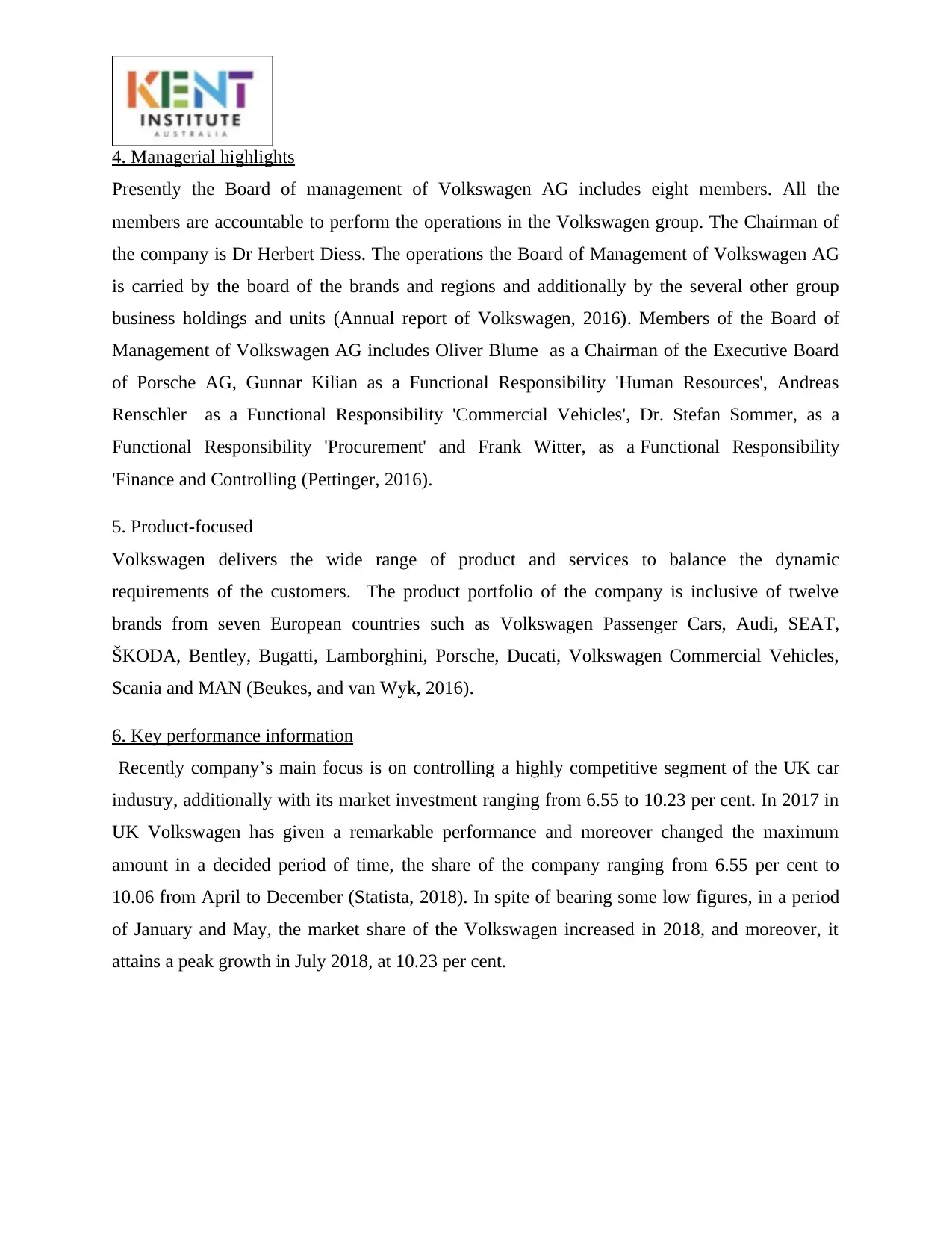
4. Managerial highlights
Presently the Board of management of Volkswagen AG includes eight members. All the
members are accountable to perform the operations in the Volkswagen group. The Chairman of
the company is Dr Herbert Diess. The operations the Board of Management of Volkswagen AG
is carried by the board of the brands and regions and additionally by the several other group
business holdings and units (Annual report of Volkswagen, 2016). Members of the Board of
Management of Volkswagen AG includes Oliver Blume as a Chairman of the Executive Board
of Porsche AG, Gunnar Kilian as a Functional Responsibility 'Human Resources', Andreas
Renschler as a Functional Responsibility 'Commercial Vehicles', Dr. Stefan Sommer, as a
Functional Responsibility 'Procurement' and Frank Witter, as a Functional Responsibility
'Finance and Controlling (Pettinger, 2016).
5. Product-focused
Volkswagen delivers the wide range of product and services to balance the dynamic
requirements of the customers. The product portfolio of the company is inclusive of twelve
brands from seven European countries such as Volkswagen Passenger Cars, Audi, SEAT,
ŠKODA, Bentley, Bugatti, Lamborghini, Porsche, Ducati, Volkswagen Commercial Vehicles,
Scania and MAN (Beukes, and van Wyk, 2016).
6. Key performance information
Recently company’s main focus is on controlling a highly competitive segment of the UK car
industry, additionally with its market investment ranging from 6.55 to 10.23 per cent. In 2017 in
UK Volkswagen has given a remarkable performance and moreover changed the maximum
amount in a decided period of time, the share of the company ranging from 6.55 per cent to
10.06 from April to December (Statista, 2018). In spite of bearing some low figures, in a period
of January and May, the market share of the Volkswagen increased in 2018, and moreover, it
attains a peak growth in July 2018, at 10.23 per cent.
Presently the Board of management of Volkswagen AG includes eight members. All the
members are accountable to perform the operations in the Volkswagen group. The Chairman of
the company is Dr Herbert Diess. The operations the Board of Management of Volkswagen AG
is carried by the board of the brands and regions and additionally by the several other group
business holdings and units (Annual report of Volkswagen, 2016). Members of the Board of
Management of Volkswagen AG includes Oliver Blume as a Chairman of the Executive Board
of Porsche AG, Gunnar Kilian as a Functional Responsibility 'Human Resources', Andreas
Renschler as a Functional Responsibility 'Commercial Vehicles', Dr. Stefan Sommer, as a
Functional Responsibility 'Procurement' and Frank Witter, as a Functional Responsibility
'Finance and Controlling (Pettinger, 2016).
5. Product-focused
Volkswagen delivers the wide range of product and services to balance the dynamic
requirements of the customers. The product portfolio of the company is inclusive of twelve
brands from seven European countries such as Volkswagen Passenger Cars, Audi, SEAT,
ŠKODA, Bentley, Bugatti, Lamborghini, Porsche, Ducati, Volkswagen Commercial Vehicles,
Scania and MAN (Beukes, and van Wyk, 2016).
6. Key performance information
Recently company’s main focus is on controlling a highly competitive segment of the UK car
industry, additionally with its market investment ranging from 6.55 to 10.23 per cent. In 2017 in
UK Volkswagen has given a remarkable performance and moreover changed the maximum
amount in a decided period of time, the share of the company ranging from 6.55 per cent to
10.06 from April to December (Statista, 2018). In spite of bearing some low figures, in a period
of January and May, the market share of the Volkswagen increased in 2018, and moreover, it
attains a peak growth in July 2018, at 10.23 per cent.
Paraphrase This Document
Need a fresh take? Get an instant paraphrase of this document with our AI Paraphraser
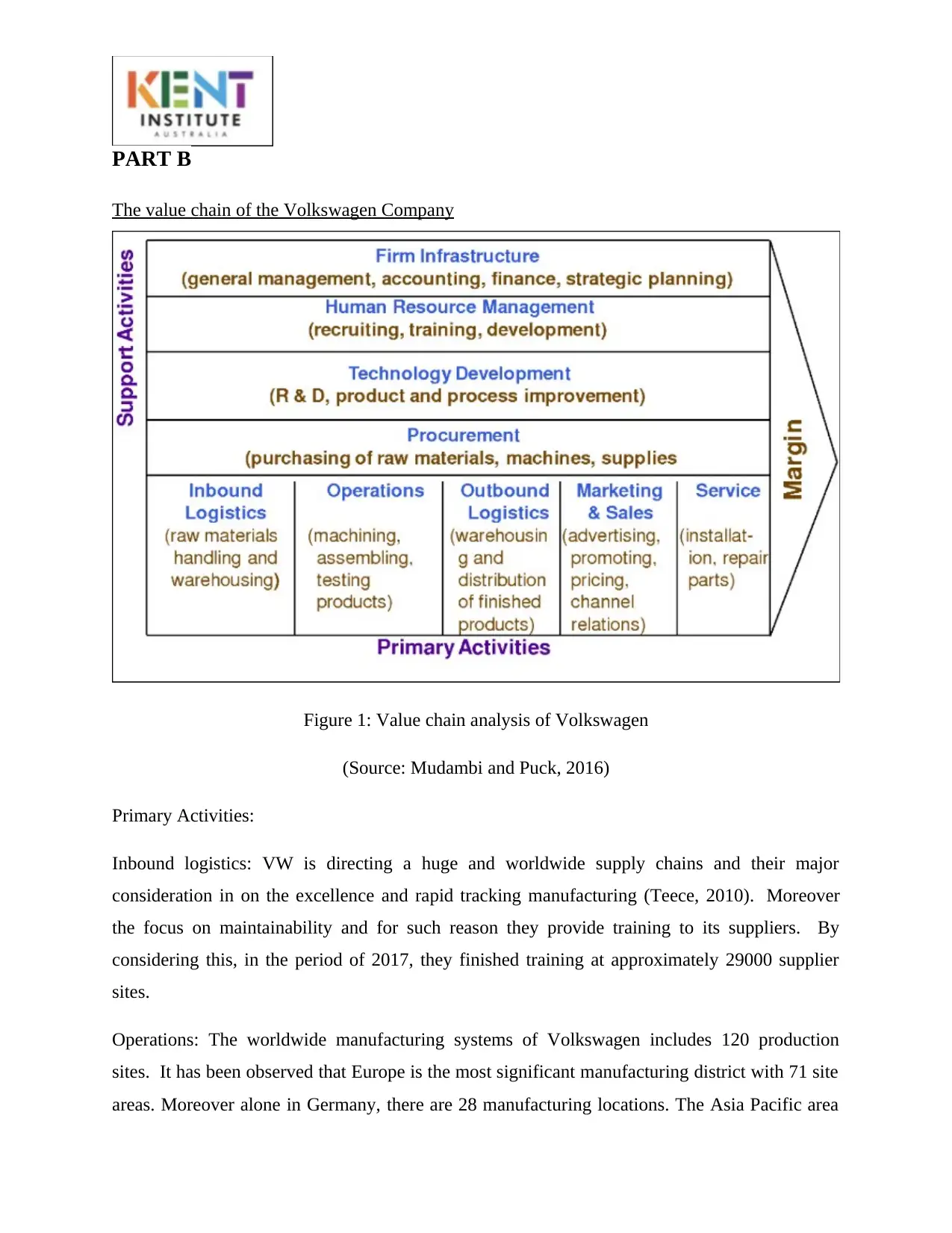
PART B
The value chain of the Volkswagen Company
Figure 1: Value chain analysis of Volkswagen
(Source: Mudambi and Puck, 2016)
Primary Activities:
Inbound logistics: VW is directing a huge and worldwide supply chains and their major
consideration in on the excellence and rapid tracking manufacturing (Teece, 2010). Moreover
the focus on maintainability and for such reason they provide training to its suppliers. By
considering this, in the period of 2017, they finished training at approximately 29000 supplier
sites.
Operations: The worldwide manufacturing systems of Volkswagen includes 120 production
sites. It has been observed that Europe is the most significant manufacturing district with 71 site
areas. Moreover alone in Germany, there are 28 manufacturing locations. The Asia Pacific area
The value chain of the Volkswagen Company
Figure 1: Value chain analysis of Volkswagen
(Source: Mudambi and Puck, 2016)
Primary Activities:
Inbound logistics: VW is directing a huge and worldwide supply chains and their major
consideration in on the excellence and rapid tracking manufacturing (Teece, 2010). Moreover
the focus on maintainability and for such reason they provide training to its suppliers. By
considering this, in the period of 2017, they finished training at approximately 29000 supplier
sites.
Operations: The worldwide manufacturing systems of Volkswagen includes 120 production
sites. It has been observed that Europe is the most significant manufacturing district with 71 site
areas. Moreover alone in Germany, there are 28 manufacturing locations. The Asia Pacific area
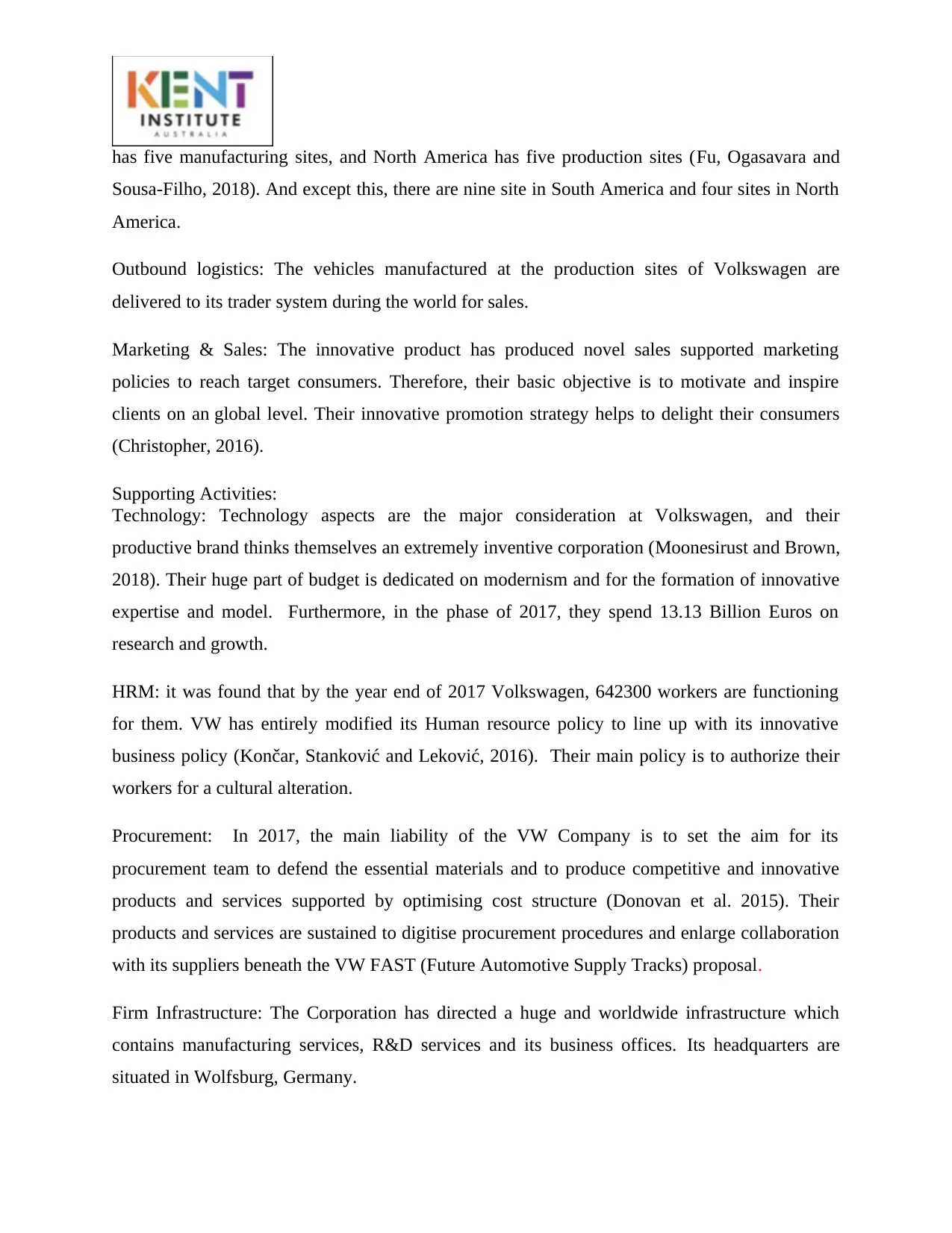
has five manufacturing sites, and North America has five production sites (Fu, Ogasavara and
Sousa-Filho, 2018). And except this, there are nine site in South America and four sites in North
America.
Outbound logistics: The vehicles manufactured at the production sites of Volkswagen are
delivered to its trader system during the world for sales.
Marketing & Sales: The innovative product has produced novel sales supported marketing
policies to reach target consumers. Therefore, their basic objective is to motivate and inspire
clients on an global level. Their innovative promotion strategy helps to delight their consumers
(Christopher, 2016).
Supporting Activities:
Technology: Technology aspects are the major consideration at Volkswagen, and their
productive brand thinks themselves an extremely inventive corporation (Moonesirust and Brown,
2018). Their huge part of budget is dedicated on modernism and for the formation of innovative
expertise and model. Furthermore, in the phase of 2017, they spend 13.13 Billion Euros on
research and growth.
HRM: it was found that by the year end of 2017 Volkswagen, 642300 workers are functioning
for them. VW has entirely modified its Human resource policy to line up with its innovative
business policy (Končar, Stanković and Leković, 2016). Their main policy is to authorize their
workers for a cultural alteration.
Procurement: In 2017, the main liability of the VW Company is to set the aim for its
procurement team to defend the essential materials and to produce competitive and innovative
products and services supported by optimising cost structure (Donovan et al. 2015). Their
products and services are sustained to digitise procurement procedures and enlarge collaboration
with its suppliers beneath the VW FAST (Future Automotive Supply Tracks) proposal.
Firm Infrastructure: The Corporation has directed a huge and worldwide infrastructure which
contains manufacturing services, R&D services and its business offices. Its headquarters are
situated in Wolfsburg, Germany.
Sousa-Filho, 2018). And except this, there are nine site in South America and four sites in North
America.
Outbound logistics: The vehicles manufactured at the production sites of Volkswagen are
delivered to its trader system during the world for sales.
Marketing & Sales: The innovative product has produced novel sales supported marketing
policies to reach target consumers. Therefore, their basic objective is to motivate and inspire
clients on an global level. Their innovative promotion strategy helps to delight their consumers
(Christopher, 2016).
Supporting Activities:
Technology: Technology aspects are the major consideration at Volkswagen, and their
productive brand thinks themselves an extremely inventive corporation (Moonesirust and Brown,
2018). Their huge part of budget is dedicated on modernism and for the formation of innovative
expertise and model. Furthermore, in the phase of 2017, they spend 13.13 Billion Euros on
research and growth.
HRM: it was found that by the year end of 2017 Volkswagen, 642300 workers are functioning
for them. VW has entirely modified its Human resource policy to line up with its innovative
business policy (Končar, Stanković and Leković, 2016). Their main policy is to authorize their
workers for a cultural alteration.
Procurement: In 2017, the main liability of the VW Company is to set the aim for its
procurement team to defend the essential materials and to produce competitive and innovative
products and services supported by optimising cost structure (Donovan et al. 2015). Their
products and services are sustained to digitise procurement procedures and enlarge collaboration
with its suppliers beneath the VW FAST (Future Automotive Supply Tracks) proposal.
Firm Infrastructure: The Corporation has directed a huge and worldwide infrastructure which
contains manufacturing services, R&D services and its business offices. Its headquarters are
situated in Wolfsburg, Germany.
⊘ This is a preview!⊘
Do you want full access?
Subscribe today to unlock all pages.

Trusted by 1+ million students worldwide
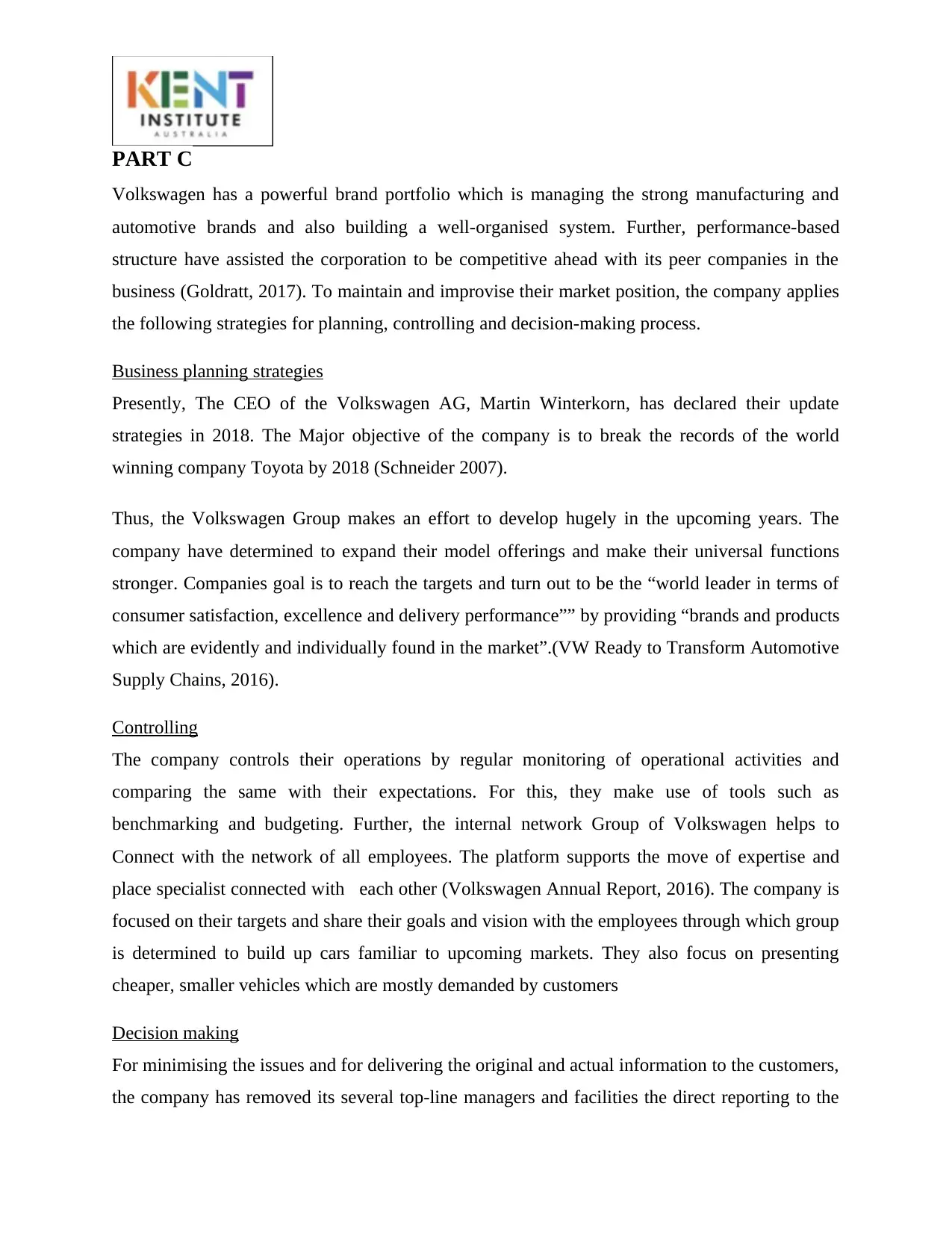
PART C
Volkswagen has a powerful brand portfolio which is managing the strong manufacturing and
automotive brands and also building a well-organised system. Further, performance-based
structure have assisted the corporation to be competitive ahead with its peer companies in the
business (Goldratt, 2017). To maintain and improvise their market position, the company applies
the following strategies for planning, controlling and decision-making process.
Business planning strategies
Presently, The CEO of the Volkswagen AG, Martin Winterkorn, has declared their update
strategies in 2018. The Major objective of the company is to break the records of the world
winning company Toyota by 2018 (Schneider 2007).
Thus, the Volkswagen Group makes an effort to develop hugely in the upcoming years. The
company have determined to expand their model offerings and make their universal functions
stronger. Companies goal is to reach the targets and turn out to be the “world leader in terms of
consumer satisfaction, excellence and delivery performance”” by providing “brands and products
which are evidently and individually found in the market”.(VW Ready to Transform Automotive
Supply Chains, 2016).
Controlling
The company controls their operations by regular monitoring of operational activities and
comparing the same with their expectations. For this, they make use of tools such as
benchmarking and budgeting. Further, the internal network Group of Volkswagen helps to
Connect with the network of all employees. The platform supports the move of expertise and
place specialist connected with each other (Volkswagen Annual Report, 2016). The company is
focused on their targets and share their goals and vision with the employees through which group
is determined to build up cars familiar to upcoming markets. They also focus on presenting
cheaper, smaller vehicles which are mostly demanded by customers
Decision making
For minimising the issues and for delivering the original and actual information to the customers,
the company has removed its several top-line managers and facilities the direct reporting to the
Volkswagen has a powerful brand portfolio which is managing the strong manufacturing and
automotive brands and also building a well-organised system. Further, performance-based
structure have assisted the corporation to be competitive ahead with its peer companies in the
business (Goldratt, 2017). To maintain and improvise their market position, the company applies
the following strategies for planning, controlling and decision-making process.
Business planning strategies
Presently, The CEO of the Volkswagen AG, Martin Winterkorn, has declared their update
strategies in 2018. The Major objective of the company is to break the records of the world
winning company Toyota by 2018 (Schneider 2007).
Thus, the Volkswagen Group makes an effort to develop hugely in the upcoming years. The
company have determined to expand their model offerings and make their universal functions
stronger. Companies goal is to reach the targets and turn out to be the “world leader in terms of
consumer satisfaction, excellence and delivery performance”” by providing “brands and products
which are evidently and individually found in the market”.(VW Ready to Transform Automotive
Supply Chains, 2016).
Controlling
The company controls their operations by regular monitoring of operational activities and
comparing the same with their expectations. For this, they make use of tools such as
benchmarking and budgeting. Further, the internal network Group of Volkswagen helps to
Connect with the network of all employees. The platform supports the move of expertise and
place specialist connected with each other (Volkswagen Annual Report, 2016). The company is
focused on their targets and share their goals and vision with the employees through which group
is determined to build up cars familiar to upcoming markets. They also focus on presenting
cheaper, smaller vehicles which are mostly demanded by customers
Decision making
For minimising the issues and for delivering the original and actual information to the customers,
the company has removed its several top-line managers and facilities the direct reporting to the
Paraphrase This Document
Need a fresh take? Get an instant paraphrase of this document with our AI Paraphraser
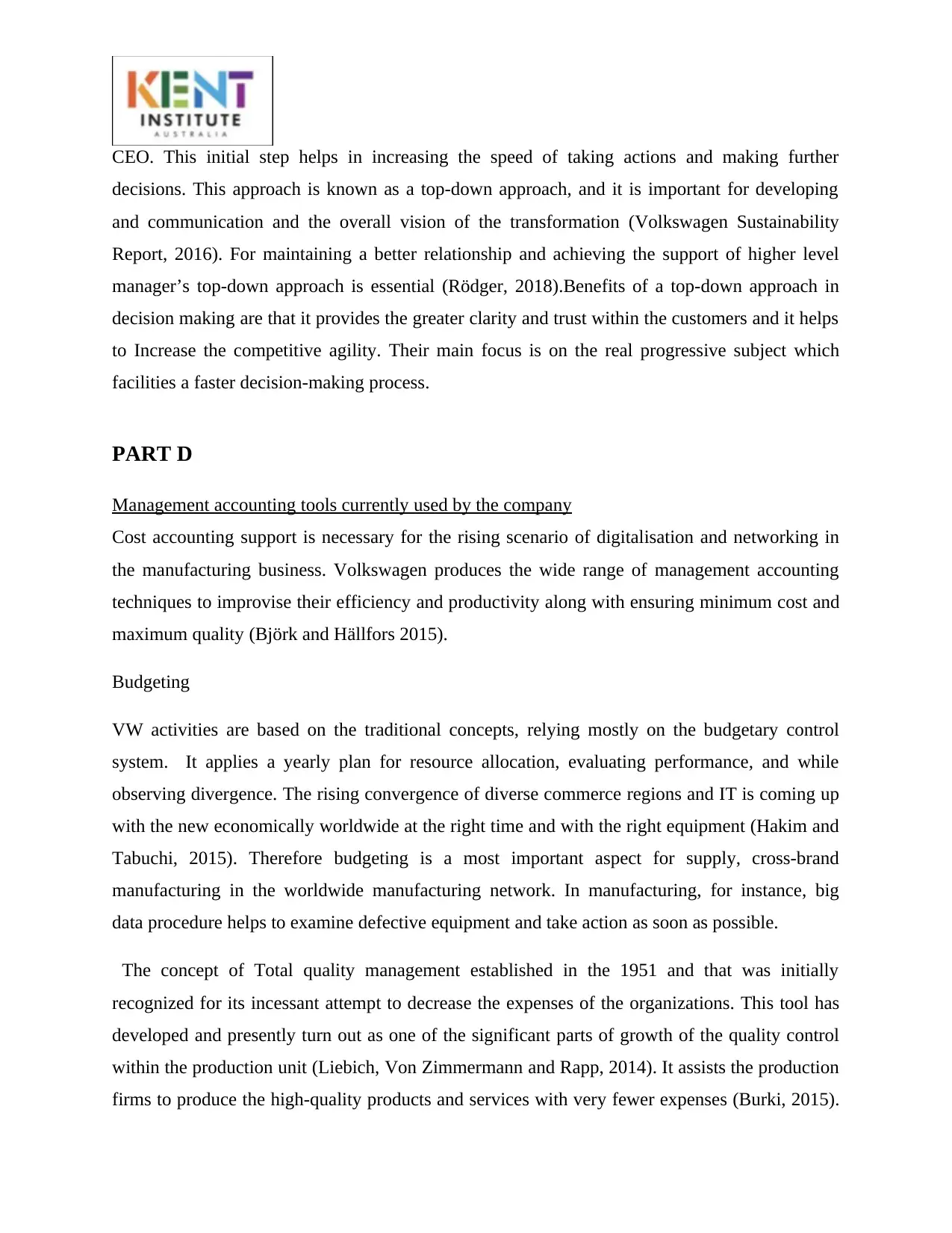
CEO. This initial step helps in increasing the speed of taking actions and making further
decisions. This approach is known as a top-down approach, and it is important for developing
and communication and the overall vision of the transformation (Volkswagen Sustainability
Report, 2016). For maintaining a better relationship and achieving the support of higher level
manager’s top-down approach is essential (Rödger, 2018).Benefits of a top-down approach in
decision making are that it provides the greater clarity and trust within the customers and it helps
to Increase the competitive agility. Their main focus is on the real progressive subject which
facilities a faster decision-making process.
PART D
Management accounting tools currently used by the company
Cost accounting support is necessary for the rising scenario of digitalisation and networking in
the manufacturing business. Volkswagen produces the wide range of management accounting
techniques to improvise their efficiency and productivity along with ensuring minimum cost and
maximum quality (Björk and Hällfors 2015).
Budgeting
VW activities are based on the traditional concepts, relying mostly on the budgetary control
system. It applies a yearly plan for resource allocation, evaluating performance, and while
observing divergence. The rising convergence of diverse commerce regions and IT is coming up
with the new economically worldwide at the right time and with the right equipment (Hakim and
Tabuchi, 2015). Therefore budgeting is a most important aspect for supply, cross-brand
manufacturing in the worldwide manufacturing network. In manufacturing, for instance, big
data procedure helps to examine defective equipment and take action as soon as possible.
The concept of Total quality management established in the 1951 and that was initially
recognized for its incessant attempt to decrease the expenses of the organizations. This tool has
developed and presently turn out as one of the significant parts of growth of the quality control
within the production unit (Liebich, Von Zimmermann and Rapp, 2014). It assists the production
firms to produce the high-quality products and services with very fewer expenses (Burki, 2015).
decisions. This approach is known as a top-down approach, and it is important for developing
and communication and the overall vision of the transformation (Volkswagen Sustainability
Report, 2016). For maintaining a better relationship and achieving the support of higher level
manager’s top-down approach is essential (Rödger, 2018).Benefits of a top-down approach in
decision making are that it provides the greater clarity and trust within the customers and it helps
to Increase the competitive agility. Their main focus is on the real progressive subject which
facilities a faster decision-making process.
PART D
Management accounting tools currently used by the company
Cost accounting support is necessary for the rising scenario of digitalisation and networking in
the manufacturing business. Volkswagen produces the wide range of management accounting
techniques to improvise their efficiency and productivity along with ensuring minimum cost and
maximum quality (Björk and Hällfors 2015).
Budgeting
VW activities are based on the traditional concepts, relying mostly on the budgetary control
system. It applies a yearly plan for resource allocation, evaluating performance, and while
observing divergence. The rising convergence of diverse commerce regions and IT is coming up
with the new economically worldwide at the right time and with the right equipment (Hakim and
Tabuchi, 2015). Therefore budgeting is a most important aspect for supply, cross-brand
manufacturing in the worldwide manufacturing network. In manufacturing, for instance, big
data procedure helps to examine defective equipment and take action as soon as possible.
The concept of Total quality management established in the 1951 and that was initially
recognized for its incessant attempt to decrease the expenses of the organizations. This tool has
developed and presently turn out as one of the significant parts of growth of the quality control
within the production unit (Liebich, Von Zimmermann and Rapp, 2014). It assists the production
firms to produce the high-quality products and services with very fewer expenses (Burki, 2015).
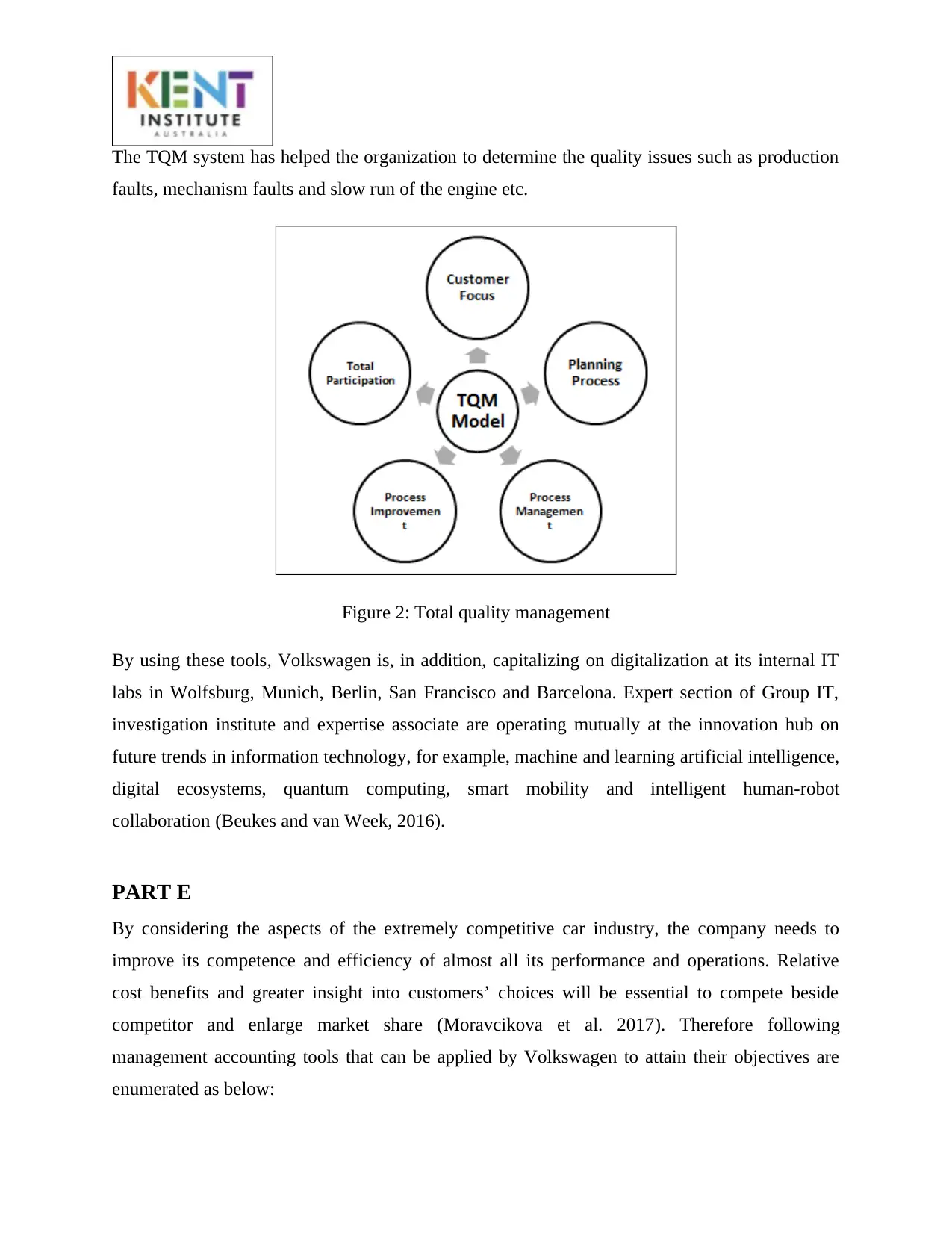
The TQM system has helped the organization to determine the quality issues such as production
faults, mechanism faults and slow run of the engine etc.
Figure 2: Total quality management
By using these tools, Volkswagen is, in addition, capitalizing on digitalization at its internal IT
labs in Wolfsburg, Munich, Berlin, San Francisco and Barcelona. Expert section of Group IT,
investigation institute and expertise associate are operating mutually at the innovation hub on
future trends in information technology, for example, machine and learning artificial intelligence,
digital ecosystems, quantum computing, smart mobility and intelligent human-robot
collaboration (Beukes and van Week, 2016).
PART E
By considering the aspects of the extremely competitive car industry, the company needs to
improve its competence and efficiency of almost all its performance and operations. Relative
cost benefits and greater insight into customers’ choices will be essential to compete beside
competitor and enlarge market share (Moravcikova et al. 2017). Therefore following
management accounting tools that can be applied by Volkswagen to attain their objectives are
enumerated as below:
faults, mechanism faults and slow run of the engine etc.
Figure 2: Total quality management
By using these tools, Volkswagen is, in addition, capitalizing on digitalization at its internal IT
labs in Wolfsburg, Munich, Berlin, San Francisco and Barcelona. Expert section of Group IT,
investigation institute and expertise associate are operating mutually at the innovation hub on
future trends in information technology, for example, machine and learning artificial intelligence,
digital ecosystems, quantum computing, smart mobility and intelligent human-robot
collaboration (Beukes and van Week, 2016).
PART E
By considering the aspects of the extremely competitive car industry, the company needs to
improve its competence and efficiency of almost all its performance and operations. Relative
cost benefits and greater insight into customers’ choices will be essential to compete beside
competitor and enlarge market share (Moravcikova et al. 2017). Therefore following
management accounting tools that can be applied by Volkswagen to attain their objectives are
enumerated as below:
⊘ This is a preview!⊘
Do you want full access?
Subscribe today to unlock all pages.

Trusted by 1+ million students worldwide
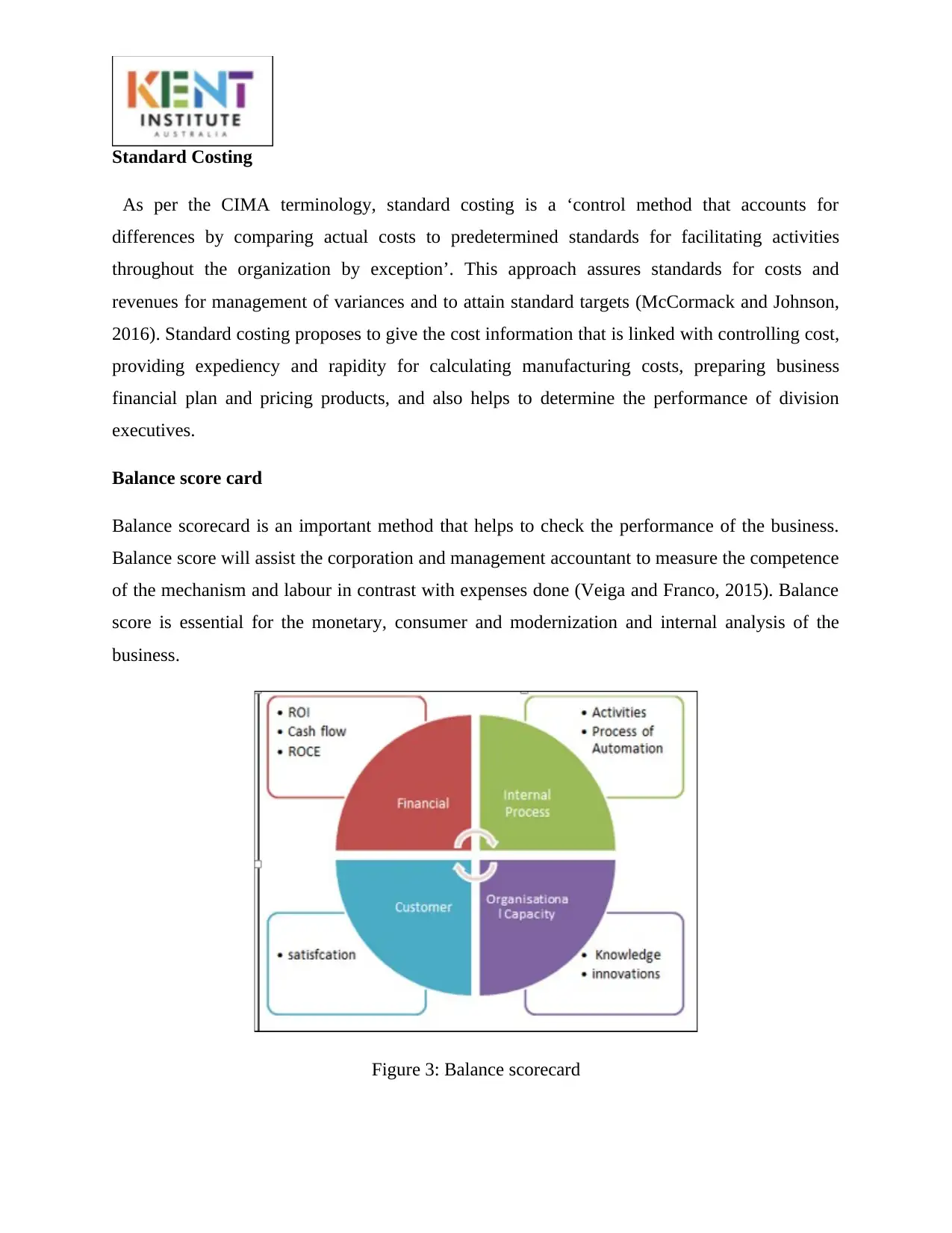
Standard Costing
As per the CIMA terminology, standard costing is a ‘control method that accounts for
differences by comparing actual costs to predetermined standards for facilitating activities
throughout the organization by exception’. This approach assures standards for costs and
revenues for management of variances and to attain standard targets (McCormack and Johnson,
2016). Standard costing proposes to give the cost information that is linked with controlling cost,
providing expediency and rapidity for calculating manufacturing costs, preparing business
financial plan and pricing products, and also helps to determine the performance of division
executives.
Balance score card
Balance scorecard is an important method that helps to check the performance of the business.
Balance score will assist the corporation and management accountant to measure the competence
of the mechanism and labour in contrast with expenses done (Veiga and Franco, 2015). Balance
score is essential for the monetary, consumer and modernization and internal analysis of the
business.
Figure 3: Balance scorecard
As per the CIMA terminology, standard costing is a ‘control method that accounts for
differences by comparing actual costs to predetermined standards for facilitating activities
throughout the organization by exception’. This approach assures standards for costs and
revenues for management of variances and to attain standard targets (McCormack and Johnson,
2016). Standard costing proposes to give the cost information that is linked with controlling cost,
providing expediency and rapidity for calculating manufacturing costs, preparing business
financial plan and pricing products, and also helps to determine the performance of division
executives.
Balance score card
Balance scorecard is an important method that helps to check the performance of the business.
Balance score will assist the corporation and management accountant to measure the competence
of the mechanism and labour in contrast with expenses done (Veiga and Franco, 2015). Balance
score is essential for the monetary, consumer and modernization and internal analysis of the
business.
Figure 3: Balance scorecard
Paraphrase This Document
Need a fresh take? Get an instant paraphrase of this document with our AI Paraphraser
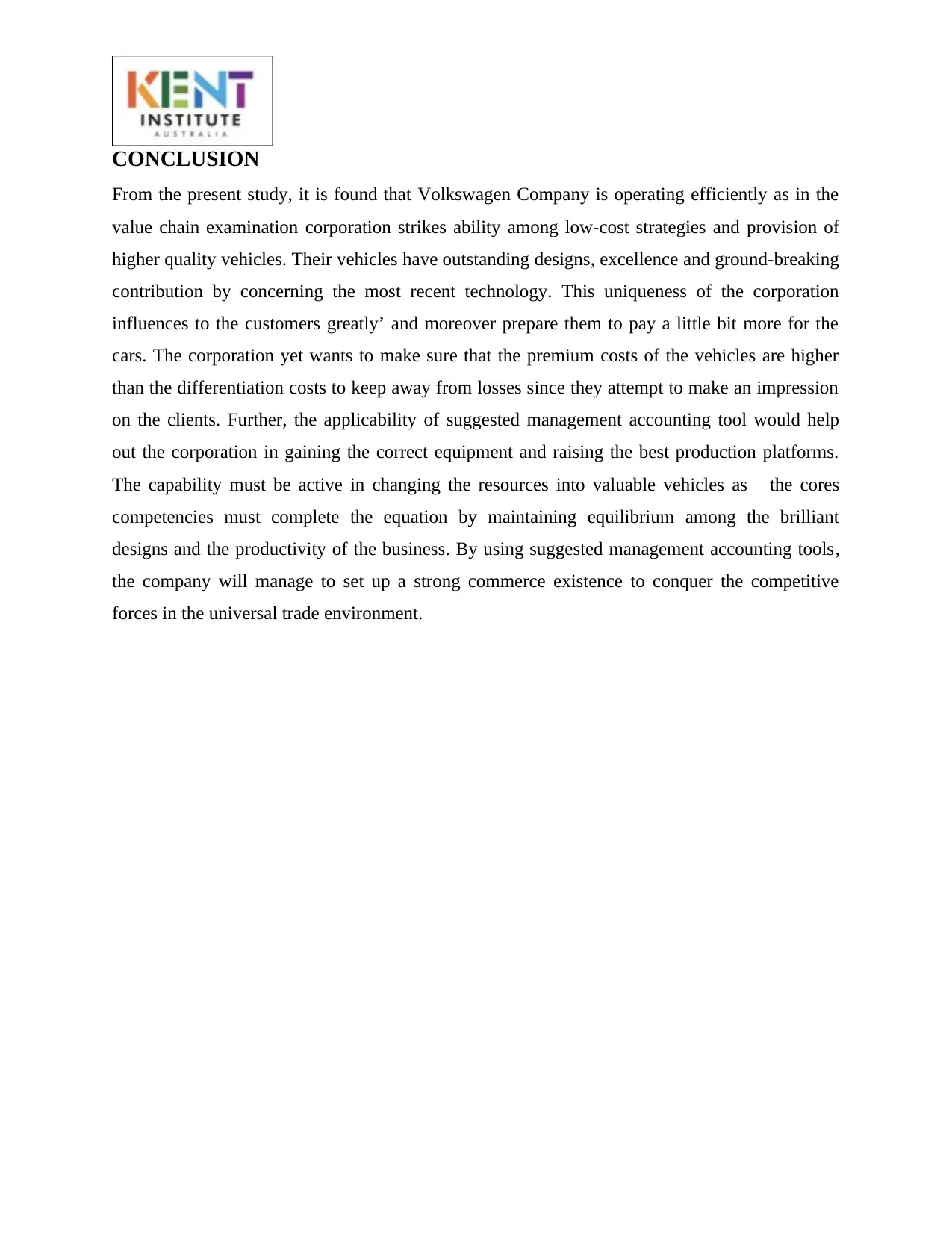
CONCLUSION
From the present study, it is found that Volkswagen Company is operating efficiently as in the
value chain examination corporation strikes ability among low-cost strategies and provision of
higher quality vehicles. Their vehicles have outstanding designs, excellence and ground-breaking
contribution by concerning the most recent technology. This uniqueness of the corporation
influences to the customers greatly’ and moreover prepare them to pay a little bit more for the
cars. The corporation yet wants to make sure that the premium costs of the vehicles are higher
than the differentiation costs to keep away from losses since they attempt to make an impression
on the clients. Further, the applicability of suggested management accounting tool would help
out the corporation in gaining the correct equipment and raising the best production platforms.
The capability must be active in changing the resources into valuable vehicles as the cores
competencies must complete the equation by maintaining equilibrium among the brilliant
designs and the productivity of the business. By using suggested management accounting tools,
the company will manage to set up a strong commerce existence to conquer the competitive
forces in the universal trade environment.
From the present study, it is found that Volkswagen Company is operating efficiently as in the
value chain examination corporation strikes ability among low-cost strategies and provision of
higher quality vehicles. Their vehicles have outstanding designs, excellence and ground-breaking
contribution by concerning the most recent technology. This uniqueness of the corporation
influences to the customers greatly’ and moreover prepare them to pay a little bit more for the
cars. The corporation yet wants to make sure that the premium costs of the vehicles are higher
than the differentiation costs to keep away from losses since they attempt to make an impression
on the clients. Further, the applicability of suggested management accounting tool would help
out the corporation in gaining the correct equipment and raising the best production platforms.
The capability must be active in changing the resources into valuable vehicles as the cores
competencies must complete the equation by maintaining equilibrium among the brilliant
designs and the productivity of the business. By using suggested management accounting tools,
the company will manage to set up a strong commerce existence to conquer the competitive
forces in the universal trade environment.
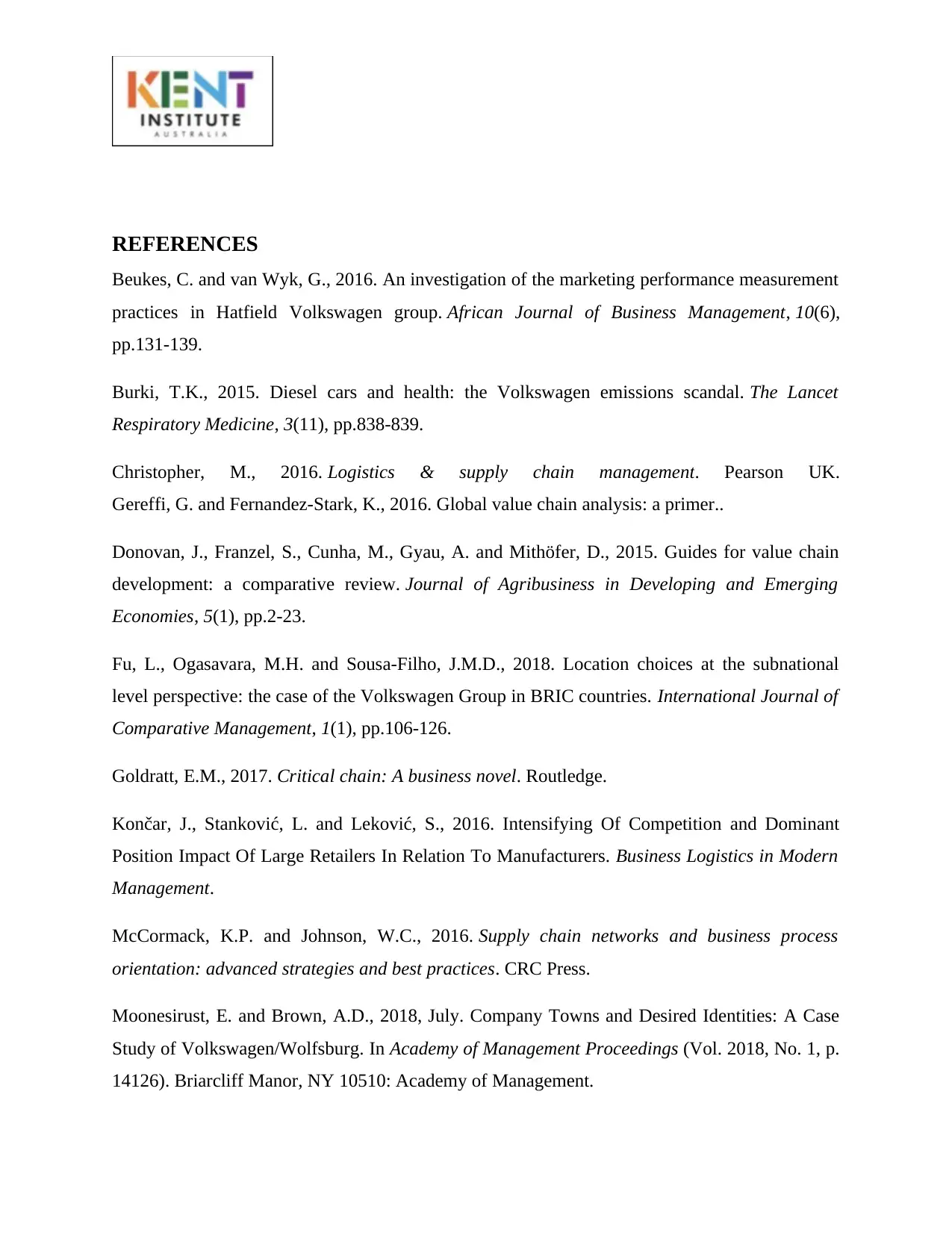
REFERENCES
Beukes, C. and van Wyk, G., 2016. An investigation of the marketing performance measurement
practices in Hatfield Volkswagen group. African Journal of Business Management, 10(6),
pp.131-139.
Burki, T.K., 2015. Diesel cars and health: the Volkswagen emissions scandal. The Lancet
Respiratory Medicine, 3(11), pp.838-839.
Christopher, M., 2016. Logistics & supply chain management. Pearson UK.
Gereffi, G. and Fernandez-Stark, K., 2016. Global value chain analysis: a primer..
Donovan, J., Franzel, S., Cunha, M., Gyau, A. and Mithöfer, D., 2015. Guides for value chain
development: a comparative review. Journal of Agribusiness in Developing and Emerging
Economies, 5(1), pp.2-23.
Fu, L., Ogasavara, M.H. and Sousa-Filho, J.M.D., 2018. Location choices at the subnational
level perspective: the case of the Volkswagen Group in BRIC countries. International Journal of
Comparative Management, 1(1), pp.106-126.
Goldratt, E.M., 2017. Critical chain: A business novel. Routledge.
Končar, J., Stanković, L. and Leković, S., 2016. Intensifying Of Competition and Dominant
Position Impact Of Large Retailers In Relation To Manufacturers. Business Logistics in Modern
Management.
McCormack, K.P. and Johnson, W.C., 2016. Supply chain networks and business process
orientation: advanced strategies and best practices. CRC Press.
Moonesirust, E. and Brown, A.D., 2018, July. Company Towns and Desired Identities: A Case
Study of Volkswagen/Wolfsburg. In Academy of Management Proceedings (Vol. 2018, No. 1, p.
14126). Briarcliff Manor, NY 10510: Academy of Management.
Beukes, C. and van Wyk, G., 2016. An investigation of the marketing performance measurement
practices in Hatfield Volkswagen group. African Journal of Business Management, 10(6),
pp.131-139.
Burki, T.K., 2015. Diesel cars and health: the Volkswagen emissions scandal. The Lancet
Respiratory Medicine, 3(11), pp.838-839.
Christopher, M., 2016. Logistics & supply chain management. Pearson UK.
Gereffi, G. and Fernandez-Stark, K., 2016. Global value chain analysis: a primer..
Donovan, J., Franzel, S., Cunha, M., Gyau, A. and Mithöfer, D., 2015. Guides for value chain
development: a comparative review. Journal of Agribusiness in Developing and Emerging
Economies, 5(1), pp.2-23.
Fu, L., Ogasavara, M.H. and Sousa-Filho, J.M.D., 2018. Location choices at the subnational
level perspective: the case of the Volkswagen Group in BRIC countries. International Journal of
Comparative Management, 1(1), pp.106-126.
Goldratt, E.M., 2017. Critical chain: A business novel. Routledge.
Končar, J., Stanković, L. and Leković, S., 2016. Intensifying Of Competition and Dominant
Position Impact Of Large Retailers In Relation To Manufacturers. Business Logistics in Modern
Management.
McCormack, K.P. and Johnson, W.C., 2016. Supply chain networks and business process
orientation: advanced strategies and best practices. CRC Press.
Moonesirust, E. and Brown, A.D., 2018, July. Company Towns and Desired Identities: A Case
Study of Volkswagen/Wolfsburg. In Academy of Management Proceedings (Vol. 2018, No. 1, p.
14126). Briarcliff Manor, NY 10510: Academy of Management.
⊘ This is a preview!⊘
Do you want full access?
Subscribe today to unlock all pages.

Trusted by 1+ million students worldwide
1 out of 14
Related Documents
Your All-in-One AI-Powered Toolkit for Academic Success.
+13062052269
info@desklib.com
Available 24*7 on WhatsApp / Email
![[object Object]](/_next/static/media/star-bottom.7253800d.svg)
Unlock your academic potential
Copyright © 2020–2025 A2Z Services. All Rights Reserved. Developed and managed by ZUCOL.





